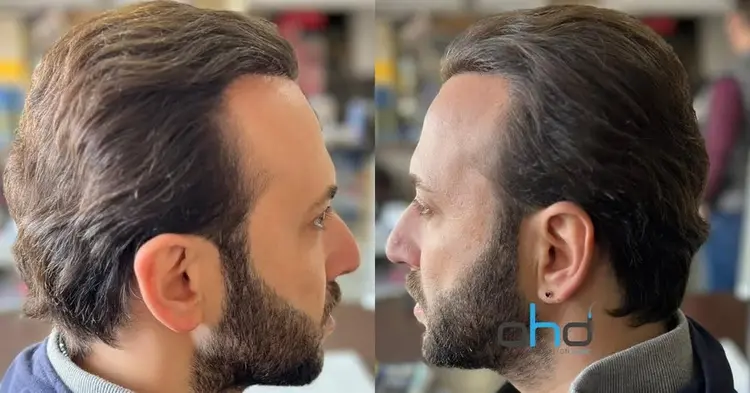We have prepared a comprehensive article to inform you about the things to pay attention to during the post-hair transplant period. You can find answers to the questions you are looking for.
After the hair transplant, a long and patience-requiring period awaits you to achieve the desired results. We understand your excitement because you’ve reached the final stage to achieve the hair you’ve always dreamed of. However, during this process, many things will come up that you should and shouldn’t do. How does the process progress after a hair transplant? What should you pay attention to? Do you know the answers to such questions? Well, in this article, you’ll find detailed answers to all these questions and more. Let’s get started.
The First 10 Days After Hair Transplant and the Recovery Period
The first 10 days, which include the recovery period, are quite important. During this time, any impact to the transplanted area could damage the newly implanted grafts. Now, let’s briefly review the post-hair transplant process from day 1 through the first 10 days and the key points you need to pay attention to.
First day
It covers the first 24-hour period following the completion of the operation. After the hair transplant, the donor area is cleaned, and a bandage is placed on your head to apply pressure. The purpose of the bandage is to prevent bleeding, which may occur as slight leakage from the donor area. Additionally, it helps reduce possible post-transplant swelling. It is recommended that this bandage or dressing not be removed until the first wash.
- • Rest in the first days and avoid heavy exercise.
- • After the operation, you can return to your home or hotel. There is no need for hospitalization.
- • Once the local anesthesia wears off, you may experience mild burning or pain. The painkillers given to you will be sufficient.
- • Follow your doctor’s instructions and start taking the prescribed medications.
The first 72 hours after a hair transplant are particularly crucial. This is because the process called epithelialization, which allows the grafts to adhere, occurs within the first three days. For the hair grafts to take hold, they must receive nourishment in their new location, the recipient area. Even the slightest trauma to the transplanted hair can cause the grafts to dislodge. Therefore, avoid any actions that may disturb the grafts, such as touching or scratching, for the first 2-3 days. This risk significantly decreases after 5 days.
What Happens in the First 1 Week to 10 Days After a Hair Transplant?
The wound healing process begins from the 1st day and continues until the 10th day. Mistakes made during this period can negatively affect the hair transplant results.
Clothing and Attire Selection
After a hair transplant, you need to be careful with your clothing choices for the first 10 days. You should opt for easy-to-wear button-up shirts or similar garments. Pullover items like turtleneck sweaters may cause friction on the transplanted area when putting them on or taking them off, which could damage the grafts.
Scabbing
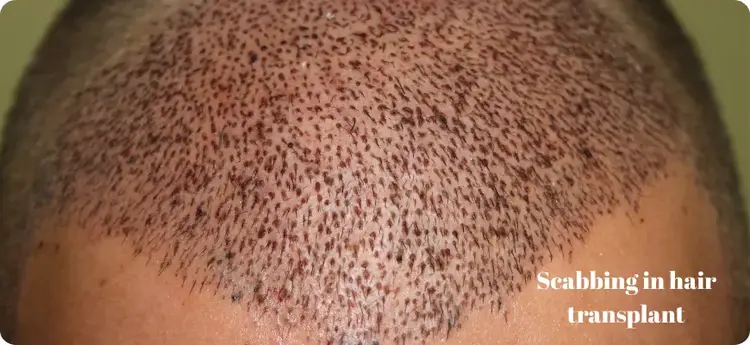
After the operation, small blood clots will form in the area where the hair transplant was performed. These clots will dry within a few hours and form scabs. This marks the beginning of the healing process. Do not touch, pick, or rub and press on these scabs, as this may harm the grafts.
Swelling
After the first 48 hours, swelling called edema may occur around the forehead, eyes, and face. This condition after hair transplantation is actually normal. Applying a cold compress to the forehead will help reduce the swelling. Avoid tilting your head forward too much and drink plenty of fluids. The swelling usually lasts about 7 days and subsides on its own by the end of the first week. While swelling is less common with the DHI technique, the Sapphire FUE technique tends to cause more swelling. We have also discussed the topic of post-hair transplant swelling in detail in another article.
Pain and Sensitivity
After the second day, there may be mild burning and pain in the donor area and the transplanted region. This is normal and can be managed with painkillers.
Itching
Itching on the scabs is also an expected complication. As a sign of wound healing, itching may begin 3–4 days after the hair transplant. Do not scratch the formed scabs under any circumstances, as the grafts are still fresh and even slight pressure can dislodge them. Post-transplant itching can persist until the 20th day. If the itching is excessive, you may use an antihistamine tablet recommended by your doctor. Washing your hair frequently and keeping it moist will help reduce itching discomfort.
Washing and Shedding of Shells
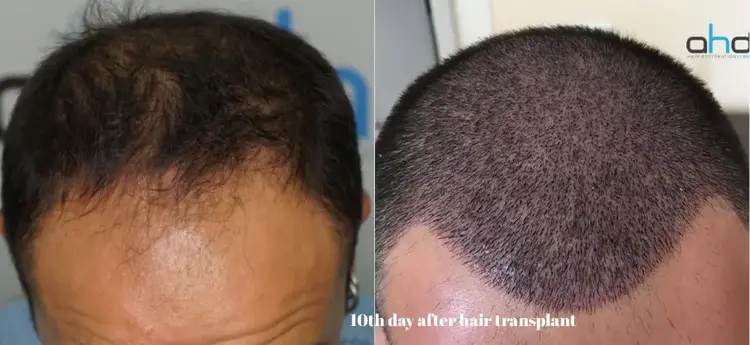
If you had a hair transplant using the DHI method, the first hair wash can be done after 24 hours, meaning from the 2nd day onward. In clinics that perform hair transplants using the classic FUE method, washing is usually done after the 3rd or 4th day. Before washing your hair, a softening cream should be gently applied to the donor area and the transplanted area, then left for about half an hour. During washing, shampoos with a pH level close to that of hair, such as baby shampoo, should be chosen.
The first washes should be done gently, as if caressing a baby’s head, without damaging the hair follicles. For this reason, high-pressure water should not be used during washing. We recommend that the first wash after the hair transplant be done at the clinic. Afterward, you can do this 2-3 times a day with lukewarm water. Avoid using a hair dryer if possible. If you must use one, opt for the cool air setting instead of the hot air.
The crusts will soften within the first 10 days and gradually diminish with each wash. Starting from the 8th day, you can wash more firmly using circular rubbing motions. In non-shaving transplant procedures, the crusts will usually blend in and camouflage among the longer hair. This makes the healing process easier to manage. By the end of the 10th day, the crusts should have completely shed. You can read more details about washing in our dedicated article on the subject, so we won’t go into specifics here.
Things to Consider After Hair Transplantation
After hair transplantation, there are some sensitive points you need to pay attention to, especially during the recovery period. Being aware of these and acting accordingly will be highly beneficial for achieving healthy results. Now, let’s briefly go over these points.
- Sleeping and Sleeping Position: After the hair transplant, it is recommended to sleep on your back for the first few days. Try to keep your head elevated while sleeping—you may use two pillows if preferred. This can also help reduce possible swelling. Avoid sleeping face down, as the newly transplanted hair follicles are still fresh and may be damaged due to friction. You can solve the sleeping issue by using a travel pillow (neck pillow). When sleeping, you may cover your pillow with the protective bed cover provided by the clinic, as leakage from the donor area may stain your pillow.
- Sexual Activity: We recommend limiting sexual activity as much as possible, especially in the first 10 days after the hair transplant. Sexual activity may increase sweating, which could harm the transplanted hair. Additionally, the risk of trauma to the hair may increase with sexual activity.
- Exercise and Sports: After the hair transplant, we advise avoiding weightlifting, intense exercise, fitness, and heavy sports for the first month. You may take light-paced walks starting from the second day.
- Smoking: Nicotine in cigarettes can delay wound healing. However, there is no proven direct effect of smoking on hair transplant results. Statements like “Quit smoking one week before and avoid smoking for one week to 10 days after the transplant” have no scientific basis. The best approach is to avoid smoking altogether, considering its harmful effects on health.
- Tea, Coffee, and Alcohol Consumption: There is no restriction on drinking tea or coffee after the transplant. However, if you consume alcohol, we recommend avoiding it during the recovery period, as alcohol may impair concentration, increasing the risk of accidentally hitting your head.
- Blood Thinners: If you regularly use the blood thinner Coumadin (Warfarin), you should stop taking it one week before the hair transplant and avoid it for one week afterward. However, blood thinners like Plavix, Aspirin, or Coraspin do not need to be discontinued—these restrictions applied to the FUT method. Since the FUE method does not involve vascular incisions, there is no need to stop these medications. It is best to consult the doctor who prescribed these medications before the transplant.
- Sauna and Steam Baths: We recommend avoiding such activities for one month, as they increase sweating. Excessive sweating should be avoided, especially during the healing period after a hair transplant.
- Tanning Beds, Swimming Pools, Sea, Sunbathing, and Similar Activities: We advise taking a break from such activities for one month. Sun exposure may negatively affect the hair follicles in the early stages. Additionally, to prevent infection, you should avoid swimming in the sea or pools for the first month after the transplant. You may use sunscreen or wear a hat to protect your scalp from the sun.
- Hat, Beanie, and Bandana Use After Hair Transplant: Since the scars will be visible in the first 10 days, you can conceal them with a hat. You can also protect the transplanted hair from environmental factors like sun and rain this way. Preferably, you may wear wide-brimmed vacation hats that do not touch the hair starting from the first day after the transplant. Avoid wearing caps, as putting them on and taking them off may rub against the transplanted hair and cause damage. After the first week, you may wear a loose bandana.
- Nutrition After Hair Transplant: Avoid excessively salty foods in the first few days, as salt causes water retention in the body and may increase swelling in the head. Drink plenty of fluids. Other than this, there are no specific dietary recommendations or restrictions for hair transplants—continuing your normal diet is sufficient. Taking Biotin (Vitamin H) after the transplant may help thicken the hair strands.
- Be Mindful of Stress: You will not see immediate results after the transplant, so avoid stress and be patient. During this period, try to forget about the transplant—don’t make it a daily focus. Return to your normal life and carry on.
Medications and Post-Hair Transplant Care
After the hair transplant, you will be given or prescribed certain medications and care products. Now, let’s briefly go over these items one by one.
- Antibiotics: Since the scalp is a highly vascularized area, the risk of infection is generally low. However, if sterile conditions are not maintained during the procedure, there is always a possibility of infection after a hair transplant. Additionally, high-risk groups such as diabetics must use preventive antibiotics post-surgery. Antibiotic creams can also be applied to the donor area.
- Painkillers: Mild pain may persist for a few days after the procedure. Pain relievers with anti-inflammatory properties can also positively contribute to the healing process.
- Edema Reducers (Steroids): In rare cases, prolonged and excessive swelling may occur. In such situations, anti-edema medications can help reduce post-transplant swelling.
- Antihistamines: If you experience severe itching, this group of medications can provide relief.
- Washing Set: This set includes a moisturizing cream and shampoo. Before washing, the goal is to soften the scabs using the moisturizing cream. It is also beneficial to use the shampoo recommended by your doctor during washing.
- Finasteride and Minoxidil: These two FDA-approved medications significantly contribute to improving hair growth rate.
Monthly Development Process After Hair Transplantation
It takes approximately 1 to 1.5 years after the hair transplant procedure to achieve the desired hair appearance and full density. This process may not progress at the same rate for everyone. The development timeline outlined below represents the general average. Now, let’s begin explaining the monthly changes with illustrative examples.
1st Month After Hair Transplantation
Within the first 10 days, the wound healing is completed. After 10 days, the scabs should have completely fallen off. Once the scabs are gone, you will be very pleased with the appearance. The transplanted hair will look very clean, as if shaved to a grade 1-2. In fact, you might even think, “I wish my hair always looked like this!” But will it stay this way forever? Unfortunately, no. The days when your morale might drop are slowly approaching.
Redness and Acne
After the scabs fall off, redness may appear in the transplanted area. People with darker skin tones experience little to no redness, while those with fair skin may notice it more prominently. Taking hot showers and sun exposure can prolong post-transplant redness. Therefore, fair-skinned individuals are advised to use lukewarm water for showers and avoid sunlight for the first 1-2 months. Redness usually disappears within 3 weeks, but in rare cases, it may persist for 2-3 months in fair-skinned people.
Along with redness, folliculitis-like acne may appear at the hair roots. If it’s not excessive, no intervention is needed—it will resolve on its own. These pimples can last up to 2 months. Acne may also occur in the donor area. If it becomes severe, appropriate antibiotic treatment may be necessary. We have covered the topic of acne in detail in another article.
Shock Loss
Starting from the 2nd week, the transplanted hair may fail to adapt to its new location, leading to a condition called shock loss. Some of the transplanted hair will gradually begin to shed. In reality, this shedding phase is a necessary resting period for the hair to grow back stronger. Many people struggle to accept this, and it can indeed be demoralizing. Shock loss can continue until the 45th day, but there’s no need to worry. The hair in the recipient area sheds from the tips, while the actual hair follicles remain dormant beneath the skin. The shed hair will start regrowing after some time. However, if bleeding accompanies the shedding, it is important to consult your doctor immediately.
Donor Area After Hair Transplantation
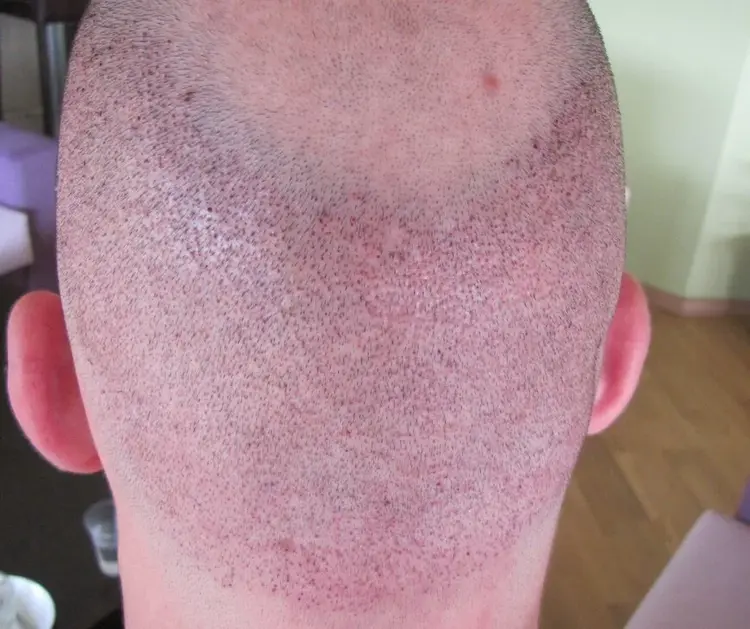
Similarly, the healing process in the donor area begins from the 2nd-3rd day. During the first washings, the donor area can be washed more firmly compared to the transplanted area. With washing, the scabs disappear quickly. The pores in the donor area where grafts were taken heal rapidly within 4-5 days. In the first week, there may be burning, pain, and tenderness in the donor area, but this can be easily managed with pain relievers.
Below, you can see the photo of the donor area on day 1
After hair transplantation, the hair in the donor area begins to grow rapidly. By the end of 1 month, the donor area completely returns to normal. However, in cases of excessive graft extraction, there may be unclosed gaps in this area. This is entirely due to incorrect graft extraction.
Numbness and Loss of Sensation
There may be numbness in both the recipient and donor areas for some time after the operation. This is due to the local anesthesia administered during the hair transplant. Typically, it begins one week after the procedure and may last for about a month. The loss of sensation is temporary and will resolve on its own, requiring no intervention. Not everyone experiences this numbness. As the number of grafts increases, the likelihood and duration of numbness may also extend.
From the beginning of the 2nd month after the hair transplant, there is no restriction on getting a haircut.
Hair Transplant: Second Month
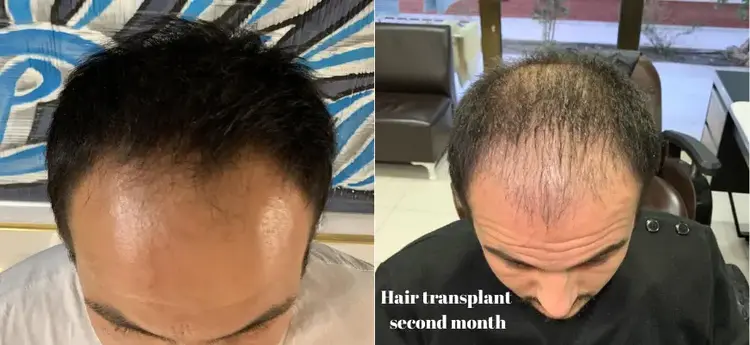
We mentioned that shock shedding can last up to 45 days. In fact, this is the month when you will feel the most unhappy after your hair transplant. Some of the transplanted hairs have shed, while others continue to grow without falling out. Due to irregular shedding, the appearance may be uneven. Hair growth has not yet started, and you are in the waiting period. Many patients enter a phase of anxious anticipation. They begin to worry whether the shed hairs will grow back. During this time, the donor area may also not fully close, and there may be partial thinning. In fair-skinned individuals, occasional redness and acne may persist.
By the 2nd month, flaking may also occur in the recipient area. If there is no excessive dandruff, no action is needed.
Hair Transplant – Month 3
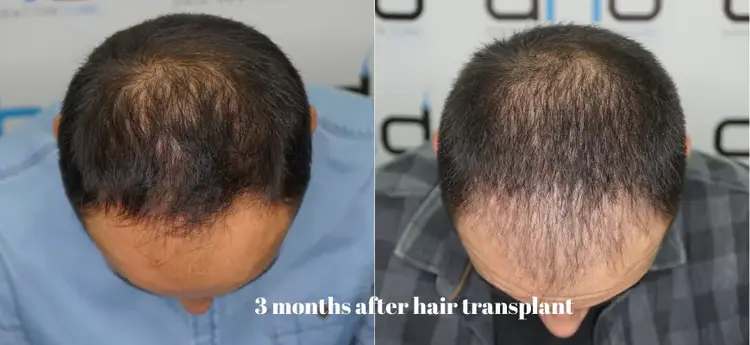
After the shock shedding phase, the shed hairs gradually begin to grow back. However, there is no significant progress yet. The first emerging hairs are quite fine and resemble baby hair. Due to the contrast between shed and non-shed areas, the appearance is not uniform. You must be patient to achieve the desired result, as it is still too early for the final outcome.
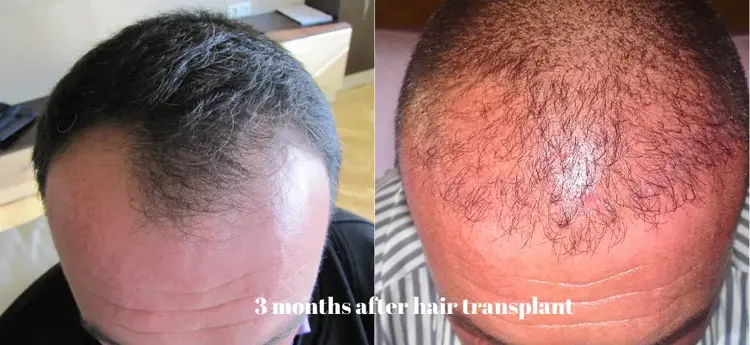
Post-Hair Transplant Months 4 and 5
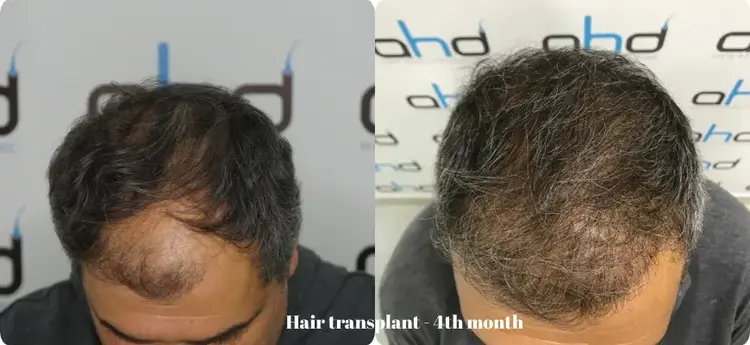
By the end of the 4th month, approximately 30% of the hair has grown out. The hair begins to thicken very slowly, and slight darkening becomes noticeable in the previously bald areas. However, the transplanted hair in the recipient area is still sparse. By the 5th month, the growth rate of new hair continues to increase.
6th Month After Hair Transplant
You are now entering a period where your concerns gradually begin to fade. By the 6th month, excitement starts to replace worry. On average, about 60-70% of hair growth is achieved six months after the transplant. However, this rate may vary from person to person. You can now comfortably comb your new hair without worry.
Months 7 and 8 After Hair Transplant
You have now entered the happiest phase after your hair transplant. There continues to be a noticeable increase in both the number and volume of your hair. You may even observe significant changes on a weekly basis. You are now gaining permanent hair that can be combed and styled. On average, about 80% of hair growth has been achieved. You can comfortably visit your barber for a haircut.
Hair Transplant at 9 Months
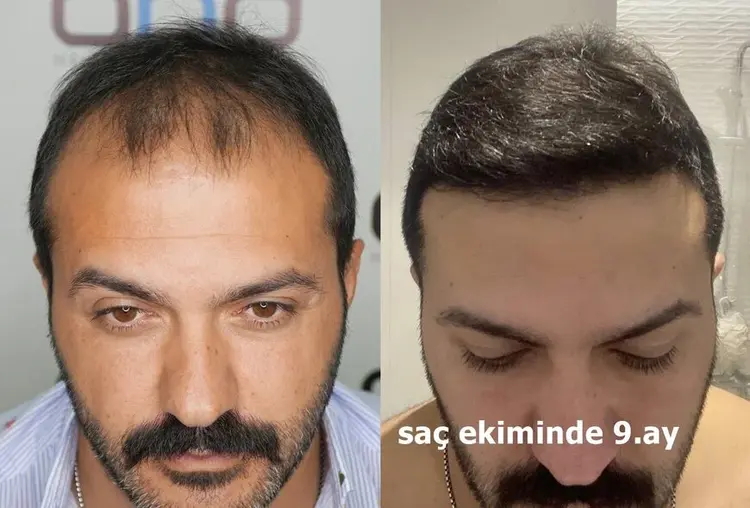
By the end of the 9th month, about 90% of the transplanted hair will have grown, reaching the desired density.
1 Year After Hair Transplant
You have now reached the final stage, where almost the full result is visible. After one year, approximately 95% of the hair will have grown. You now have natural, thick hair that can be combed.
12-18 Months After Hair Transplant
The hair growth cycle is completely finalized by the 18th month. However, for hair transplanted to the crown area, the full result may take up to 15 months.
Clinical Follow-Up and Tracking Progress with Photos
The doctor or clinic that performed your hair transplant should provide support for at least one year and conduct periodic check-ups. During this long process, not everything may go as planned. In case of a possible complication after the hair transplant, you might not know what to do. Therefore, you should maintain regular communication with your doctor throughout this period.
Additionally, one of the essential aspects of a hair transplant journey is taking photos that document the changes over time. After a while, words fade, and the photos speak for themselves. For this reason, take photos at regular intervals (e.g., once a month) and share them with your doctor. Also, stay informed about your progress at certain intervals.
When can I use hair dye, gel, or Toppik after a hair transplant?
It is absolutely not recommended to use such products for the first month.
Can I use a comb after a hair transplant?
There is no restriction on using a comb on the transplanted hair. However, it takes about 6 months for the hair to reach a length that can be combed. By the end of 6 months, the transplanted hair will have grown to about 3-4 cm.
Is minoxidil necessary after a hair transplant?
Minoxidil is an FDA-approved medication that helps with hair growth. It dilates blood vessels, increasing blood flow to the recipient area. Improved blood circulation enhances hair nourishment. Additionally, studies indicate that minoxidil use reduces shock hair loss.
Can I wear a cap after a hair transplant?
If your profession requires wearing a cap (for example, if you are a doctor), you can wear one 24 hours after the transplant. However, you must remove it before sleeping.
How soon can I return to work after a hair transplant?
If you work a desk job and your employer allows it, you can return to work after 48 hours. However, if you work in the food industry (e.g., as a waiter), you should take a break for at least 10 days until the scabs fall off.

